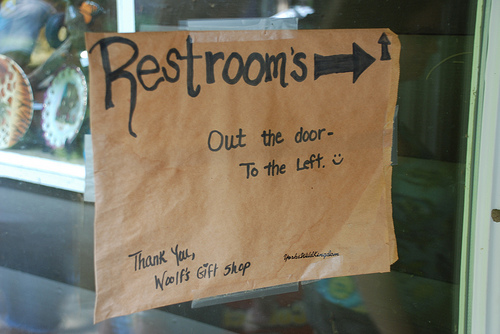The apostrophe is an innocuous-looking thing, but it does have the power to screw things up – just like the comma. I don’t know about you, but I feel so uncomfortable when I see signs and other written material that look like the following.
 Photo credit: Jeffrey Hill
Photo credit: Jeffrey Hill
 Photo credit: Quezi
Photo credit: Quezi
So what’s wrong with the images?
While not everyone has the same issues with apostrophes, we cannot deny that there are a lot of people who struggle with the use of this squiggly punctuation mark. I know some people who are reasonably good writers but still sometimes put an apostrophe when there should be none. Let me know what you think about the following examples, and then tell me what the apostrophe is doing there.
I consider myself to be a child of the ’80’s.
So is this right or wrong? I remember seeing this form used so often that at one point, I questioned my knowledge. When I looked it up, my doubts were erased. We do not use an apostrophe when writing the plural form of a noun – word or number. This sentence should therefore be written as: I consider myself to be a child of the ’80s.
Don’t forget to dot your i’s.
What’s the first apostrophe doing there? This one’s easy: we use an apostrophe for contractions. The apostrophe is always placed where the omitted letter would have been if it were not omitted.
How about the second apostrophe? The sentence obviously refers to the letter “i” – and lots of it. In the previous example, we just established that we do not use an apostrophe when writing the plural form of a noun. Shouldn’t that last word be “is” then?
You can easily spot why the apostrophe is necessary in this case. If you omit the apostrophe, the sentence will become ambiguous. Are you referring to many i’s or are you referring to the verb?
They’re fixing Silas’s bike.
What’s the apostrophe doing in the third word? I’ve heard how this form looks weird to some people, but it is actually correct. We use an apostrophe to show possession. Even if the name ends in s, the apostrophe is required. What can be changed is the presence of the second s. This is not required – the sentence can actually be re-written as:
They’re fixing Silas’ bike.
The first form, however, is preferable.
The store just received a new shipment of DVD’s.
Remember the first rule – do not use an apostrophe for plural nouns. You know how to fix this one!
To sum it up, use an apostrophe:
- to indicate possession;
- to write contractions; and
- to avoid ambiguity in meaning (as with the letter i).

Leave a Reply